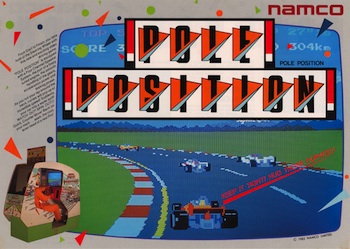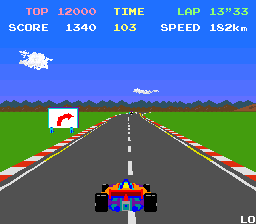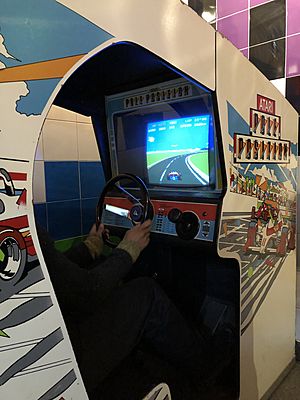Pole Position facts for kids
Quick facts for kids Pole Position |
|
|---|---|

Advertising flyer
|
|
| Developer(s) | Namco |
| Publisher(s) |
|
| Designer(s) | Kazunori Sawano Sho Osugi Shinichiro Okamoto |
| Programmer(s) | Koichi Tashiro |
| Composer(s) | Nobuyuki Ohnogi Yuriko Keino |
| Platform(s) | Arcade, Atari 2600, Atari 5200, Atari 8-bit, Commodore 64, TI-99/4A, VIC-20, Vectrex, Mobile phone |
| Release date(s) |
|
| Genre(s) | Racing (simulation) |
| Mode(s) | Single-player |
Pole Position is an arcade racing simulation video game released by Namco in 1982 and licensed to Atari, Inc. for US manufacture and distribution, running on the Namco Pole Position arcade system board. It is considered one of the most important titles from the golden age of arcade video games. Pole Position was an evolution of Namco's earlier arcade racing electro-mechanical games, notably F-1 (1976), whose designer Sho Osugi worked on the development of Pole Position.
The game was a major commercial success in arcades. After becoming the highest-grossing arcade game of 1982 in Japan, it went on to become the most popular coin-operated arcade game internationally in 1983. In North America, it was the highest-grossing arcade game for two years in 1983 and 1984 and still one of the top five arcade video games of 1985.
It was the most successful racing game of the classic era, spawning ports, sequels, and a Saturday morning cartoon, although the cartoon had very little in common with the game. The game established the conventions of the racing game genre and its success inspired numerous imitators. Pole Position is regarded as one of the most influential video games of all time, and it is considered to be the most influential racing game in particular. Its sequel, Pole Position II, was released in 1983.
Gameplay
In this game, the player controls a Formula One race car and has to complete a time trial lap within a certain amount of time (between 57 and 120 seconds) to qualify for an F1 race at the Fuji Racetrack. After qualifying, the player races against seven other CPU-controlled cars in a championship race (but if they do not qualify, the car will stay on the track until the timer runs out). The player must also avoid going off the road so that they will not crash into the billboards. Play continues until either time runs out in any lap and/or complete four laps of the race, which ends the game.
Pole Position was the first racing video game to feature a track based on a real racing circuit. It was also the first game to feature a qualifying lap, requiring the player to complete a time trial before they can compete in Grand Prix races. Once the player has qualified, they must complete the race in the time allowed, avoiding collisions with CPU-controlled opponents and billboards along the sides of the track. The game's North American distributor, Atari, publicized the game for its "unbelievable driving realism" in providing a Formula 1 experience behind a racing wheel. The game's graphics featured full-colour landscapes with scaling sprites, including race cars and other signs, and a pseudo-3D, third-person, rear perspective view of the track, with its vanishing point swaying side to side as the player approaches corners, accurately simulating forward movement into the distance. While earlier three-dimensional arcade driving games emphasized staying on the road while avoiding crashes, Pole Position gives a higher reward for passing rival cars and finishing among the leaders.
Cabinet
Pole Position was released in two configurations: a standard upright cabinet and an environmental/cockpit cabinet. Both versions feature a steering wheel and a gear shifter for low and high gears, but the environmental/cockpit cabinet featured both an accelerator and a brake pedal, while the standard upright one only featured an accelerator pedal.
Development
Pole Position was created by both Shinichiro Okamoto and Galaxian designer Kazunori Sawano. Namco electro-mechanical game engineer Sho Osugi also assisted with development. Based on Namco's experience with producing coin-operated electro-mechanical driving games in the 1970s, notably F-1 (1976) designed by Sho Osugi, Sawano showed Okamoto rough sketches of his idea, who liked the idea and began production of a video racing game. Okamoto wanted the game to be a true driving simulation game that used a 3D perspective and allowed the player to execute real-world techniques. He also chose to add the Fuji Speedway into the game to make newer players recognize it when they first played. Music was jointly composed by Nobuyuki Ohnogi and Yuriko Keino.
Development of the game lasted for three years. Okamoto recalls the most challenging part of development being to produce the hardware needed to run it, as the game was too "ambitious" to run on older hardware. The development team used two 16-bit processors to power the game, which Okamoto says was an unheard-of concept for arcade games at the time — for a while, it was the only video game to use a Z8000 CPU. Pac-Man creator Toru Iwatani chose the name Pole Position as he thought it sounded "cool" and appealing, and he shortly after filed a trademark for it. The controls also proved to be a challenge, as Okamoto wanted them to feel realistic and to match up with the gameplay — Osugi remembers Namco president Masaya Nakamura becoming frustrated with them, having difficulty keeping the car moving in a straight line.
The game's arcade cabinet, a sit-down "environmental" machine, was chosen due to their popularity at the time. The development team had long fights over how fast the gear-shift should be, until it was ultimately decided to simply be either high or low speed.
Release
Pole Position was officially released in Japan on September 16, 1982. It was licensed out to Atari, Inc. for release in North America, where it made its debut at Chicago's 1982 Amusement & Music Operators Association (AMOA) show, held during November 18–20, before receiving a mass-market North American release on November 30, 1982, while Namco themselves released the game in Europe in late 1982. After its release, Osugi stated that all of Namco's older electro-mechanical driving games were discontinued, as the company saw the future of arcade racers in the form of video games.
Advertising
The game is an early example of product placement within a video game, with billboards around the track advertising actual companies.
The game was also featured in a TV commercial shown only on MTV. It was part of a series of TV spots that Atari created in the 1980s exclusively for MTV.
Legacy
It was the most successful racing game of the classic era, spawning ports, sequels, and a Saturday morning cartoon.
The game spawned a number of clones, such as Top Racer from Commodore International, which led to a lawsuit from Namco against Commodore Japan that led to the seizure of Top Racer copies.
Other media
The title spawned a Saturday morning cartoon of the same name.
Parker Brothers published the Pole Position board game in 1983.
See also
 In Spanish: Pole Position (videojuego) para niños
In Spanish: Pole Position (videojuego) para niños



